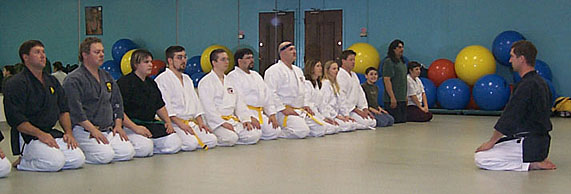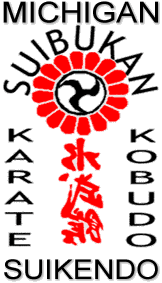

Karate is a fighting art, a way of thinking, a way of moving, a sport, a way of
keeping fit and a way of life. The Japanese word 'karate' is derived from
'kara,' meaning empty, and 'te', meaning hand, together conveying the
idea of empty hand or hand without weapon. Karate originated from Okinawa,
an island south of Japan, around 400 years ago. Its popularity spread
throughout Japan during the 20th century.
What style is best? There is no good or bad karate - like music
has many styles, so does karate. It is simply a matter of good and
bad teachers. A good teacher possesses knowledge of all of his
teachings, has self-esteem, and is able to communicate easily
his knowledge through good karate technique, good attitude and
a moral code of ethics.
Why choose karate? The very exercise involved in karate strengthens
the body physically. You must utilize all of your muscles while
focusing your mental awareness. Together then you will attain
swiftness, power and endurance, flowing as water. Karate brings
a higher level of concentration. Training properly in the
oriental martial arts gives you all of these things as well as a
good life attitude. You become more in tune with your natural
senses, as mind and body are re-introduced, as well as receiving
the the stress reduction benefit associated with exercise.
What is Suibukan? The word comes from the word "sui" meaning
water, "bu" meaning way of the warrior, and "kan" meaning
place or school. Translated means school of the warrior who
moves like water. What is taught at Michigan Suibukan? The Michigan
Suibukan is directed by Sensei David Hayes, 6th Degree Black Belt, student
of Master Tadashi Yamashita, 9th Degree Black Belt.
We practice the traditional fighting arts of Okinawan Shorin-Ryu Karate-Do,
Yamashita/Matayoshi Kobudo and Yamashita Suikendo at the dojo.
Shorin-Ryu Karate Do is the oldest and most popular in Okinawa.
The roots of the style lie in the most widely known Chinese
systems, and it was used as the basis for the development of the
best known Japanese systems, such as Shoto-Kan and Wado-Ryu.
In Okinawa it is the most eclectic system of karate, and is
considered the system of the warrior class. This system is
taught through the traditional kata, its application or
'bunkai,' and pre-arranged and freestyle fighting.
Yamashita/Matayoshi Kobudo is the most recognized weapons system
of Okinawa. The traditional weapons taught include the Bo, Sai,
Tunfa, Nunchuku, Kama, Aiku, Nunti, etc. The system is taught
through the traditional kata and pre-planned fighting techniques.
The third art taught at Michigan Suibukan is Suikendo, developed exclusively
by Master Tadashi Yamashita. This art is taught at the advanced levels.
This art form is the conclusion of the in-depth study of the traditional
Shorin-Ryu. It is characterized by its fluid motion and its effectiveness,
which is achieved with minimum use of muscle strength but maximum results
and efficiency of motion. This culminates from the mastery of the 7 essential
skills of karate techniques: 1) Balance 2) Coordination 3) Speed 4) Power
5) Distance 6) Timing, and the most important, 7) Relaxation. The ability
to relax while in the midst of an altercation does not come from just
a loose feeling in the muscles but comes from knowing the material totally,
to where you don't have muscle tension. This knowing comes only from years
of training in the way of Karate-Do.
The Michigan Suibukan is dedicated to the development of
the oriental Fighting Arts in the best possible way. It
is our belief that exercising in the traditional Fighting
Arts, in the correct way, contributes simultaneously to
the individual and the society in which it is taught.
There are without a doubt differences between the 21st
century U.S.A. and the culture from which these arts
were originated. Despite this, with the correct understanding
and study of the culture from which these arts came from,
they can be in our opinion useful even today.
Sensei David Hayes, August 2004

